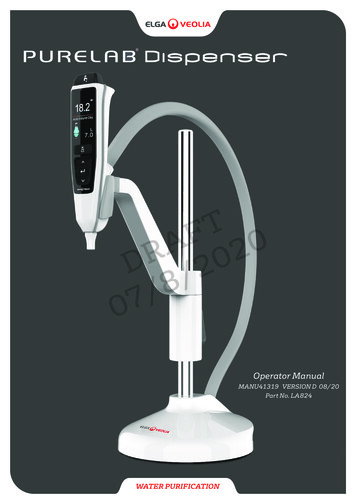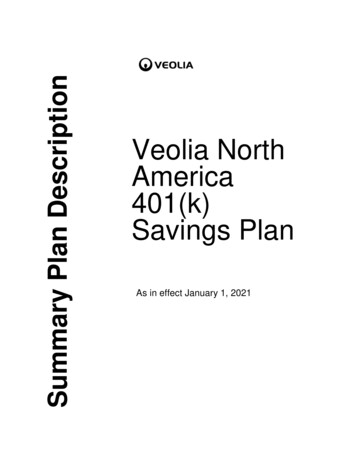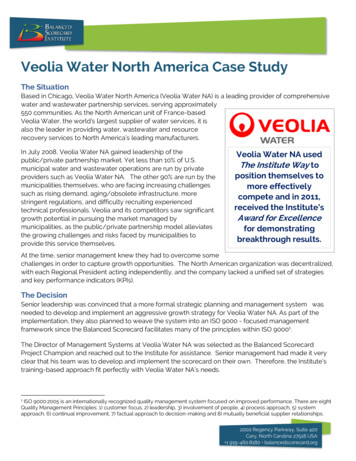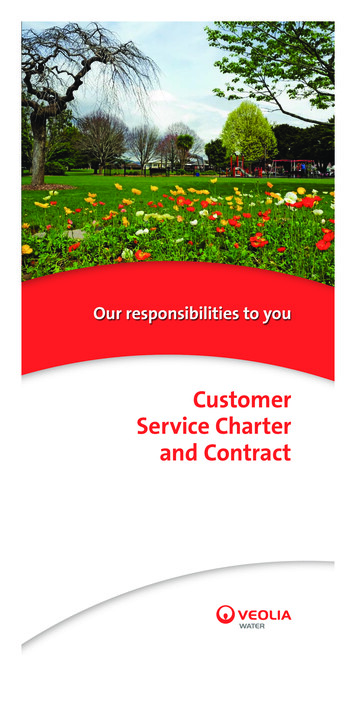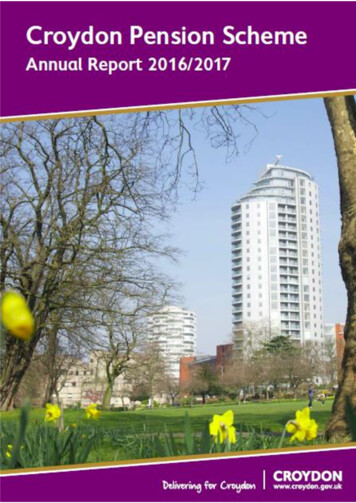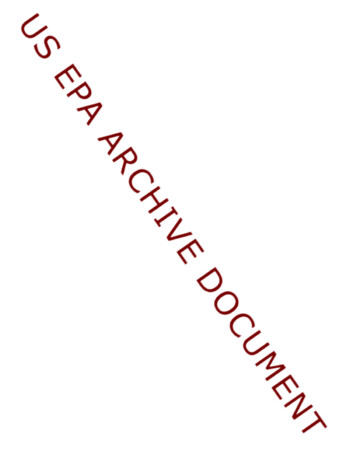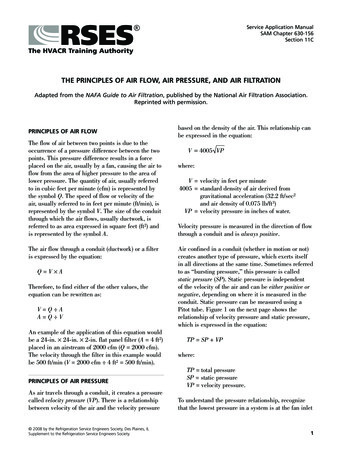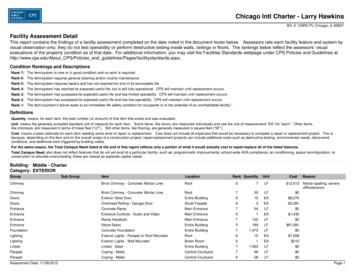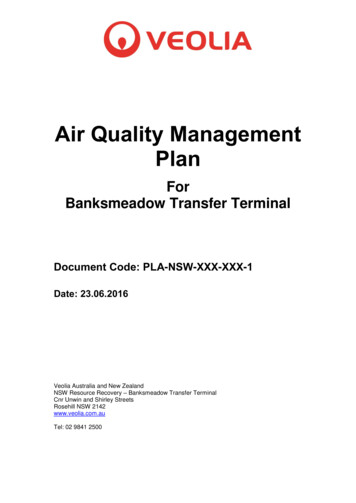
Transcription
Air Quality ManagementPlanForBanksmeadow Transfer TerminalDocument Code: PLA-NSW-XXX-XXX-1Date: 23.06.2016Veolia Australia and New ZealandNSW Resource Recovery – Banksmeadow Transfer TerminalCnr Unwin and Shirley StreetsRosehill NSW 2142www.veolia.com.auTel: 02 9841 2500
Page:Document:Date:PLANPage 2 of 33PLA-NSW-XXX-XXX-123.06.2016Air Quality ManagementQUALITY INFORMATIONDocument Revision RegisterPreparedbyR BachuNSWEnvironmentOfficerReviewedByFinal DraftR BachuNSWEnvironmentOfficerM ChilcottDirector–LinchpinEnvironmentalPty LtdC tand Projects15 Apr 2016FinalR BachuNSWEnvironmentOfficerA BrarEnvironmentalPlannerC tand Projects23 Jun 2016RevRevision Details0Initial draft for internalreview01AuthorisedByDate17 Feb 2016Printed documents are uncontrolled versions. Check printed copies against the current electronic version for validity.
Page:Document:Date:PLANPage 3 of 33PLA-NSW-XXX-XXX-123.06.2016Air Quality ManagementTABLE OF CONTENTSQuality Information . 2Definitions/Abbreviations . 4Section 1 Introduction . 51.1Overview . 51.2Scope and Objectives. 51.3Legal and Other Requirements . 61.4Stakeholder Consultation . 11Section 2 Goals of AQMP. 132.1Dust Goals. 142.2Odour Goals . 152.3Roles and Responsibilities . 15Section 3 Existing Environment and Operational Impacts . 173.1Existing Environment . 173.2Predicted Air Quality Impacts . 18Section 4 Air Quality Management Measures . 204.1Dust Control Measures . 204.2Odour Control Measures . 22Section 5 Air Quality Monitoring and Reporting . 255.1Monitoring Program . 255.2Performance Reporting and Review . 255.3Exceedances and Corrective Actions . 265.4Publishing of Monitoring Data . 28References . 29Appendices . 30Appendix A . BTT Housekeeping ChecklistAppendix B . Odour Management ProcedureAppendix C . Beaufort Wind ScalePrinted documents are uncontrolled versions. Check printed copies against the current electronic version for validity.313233
Page:Document:Date:PLANPage 4 of 33PLA-NSW-XXX-XXX-123.06.2016Air Quality ManagementDefinitions/AbbreviationsAQMPAir Quality Management PlanBTTBanksmeadow Transfer TerminalDADevelopment ApplicationDDDMPDepositional DustDust Management PlanDPEEISDepartment of Planning and EnvironmentEnvironment Impact StatementEMPEP&AEPAEPLEnvironment Management PlanEnvironmental Planning and Assessment (Act and Regulations)NSW Environment Protection AuthorityEnvironment Protection LicenceERPEmergency Response PlanNIMSNational Integrated Management SystemOEMPOperational Environmental Management PlanOMPOUOdour Management PlanOdour UnitPM2.5, PM10POEOParticulate MatterProtection of the Environment Operations (Act and Regulations)The VaultVeolia Incident and Compliance Management SystemSMPSite Management PlanTPATonnes per annumTSSVeoliaTotal Suspended SolidsVeolia Australia and New ZealandPrinted documents are uncontrolled versions. Check printed copies against the current electronic version for validity.
Page:Document:Date:PLANAir Quality ManagementSECTION 11.1Page 5 of eolia Australia and New Zealand (Veolia) operates the Banksmeadow TransferTerminal (BTT), which is located at 14 Beauchamp Road and 34-36 McPhersonStreet, Banksmeadow (refer to site plans in OEMP Appendix A).The BTT facility has been approved receive up to 500,000 tonnes per annum (TPA) ofwaste (including 400,000 TPA of putrescible waste and 100,000 TPA of nonputrescible waste) from within the Sydney Region. The waste will be containerised andloaded onto rail wagons for transportation by rail to the Woodlawn Eco Project Site(owned and operated by Veolia) in the Southern Tablelands (approximately 250kilometres southwest of Sydney) for treatment, recycling and energy recovery.The BTT includes the following infrastructure: An access road for waste trucks entering and exiting the facility fromBeauchamp Road. Incoming and outgoing weighbridges to check the waste type and weight of thewaste being delivered to the facility. An enclosed building for the unloading and handling of waste, withenvironmental controls such as dust suppression and odour control systems. A hardstand area for temporary storage and manoeuvring of full and emptysealed shipping containers prior to loading on to trains. Rail sidings for the loading of containers onto trains for rail transport toWoodlawn.The NSW Department of Planning and Environment (DPE) assessed the StateSignificant development (SSD 5855) and granted Development Consent for the ‘StateSignificant’ development on 28 April 2015, in accordance with section 89 (e) of theEnvironmental Planning and Assessment Act 1979 (EP&A Act).In addition, an Environmental Protection Licence (EPL) has been issued under theProtection of the Environment Operations Act 1997 (POEO Act) by the NSWEnvironment Protection Authority (EPA).This Air Quality Management Plan (AQMP) has been prepared in accordance with therequirements of the Conditions of Development Consent (the Consent Conditions) andEnvironment Protection Licence issued for the BTT. The AQGGMP ensures that airquality impacts, from the activities undertaken during its operational phase are suitablymanaged and details the relevant control strategies and monitoring procedures.The AQMP incorporates the Dust Management Plan and the Odour ManagementPlan.1.2Scope and ObjectivesThe purpose of this AQMP is to provide, in accordance with Consent Conditions, EPL,relevant legislation and as part of Veolia’s National Integrated Management System(NIMS), air quality management procedures to form part of the BTT OperationalEnvironmental Management Plan (OEMP).Printed documents are uncontrolled versions. Check printed copies against the current electronic version for validity.
Page:Document:Date:PLANPage 6 of 33PLA-NSW-XXX-XXX-123.06.2016Air Quality ManagementThe OEMP is the working environmental management tool for the operation of theBTT, concentrating on key environmental issues, including supporting detailed plansfor the management of water quality, waste, traffic, air quality, noise, landscape andvegetation and emergency response.This AQMP provides information on the key air quality issues including dust, odour, asfollows: Quantitative assessment of the potential air quality impacts for the BTT inaccordance with relevant EPA guidelines and requirements; Detailed emission control techniques/practices to be employed; Details of ongoing management and monitoring measures for preventingand/or minimising air quality point and fugitive emissions; and Systems for measuring and reporting the effectiveness of the adopted airquality control measures demonstrating compliance with relevant regulatoryframework.1.3Legal and Other RequirementsThe following regulatory framework applies to this AQMP: 1.3.1Development Consent (DA SSD 5855) issued under the EnvironmentalPlanning and Assessment Act 1979Environment Protection Licence (EPL 20581) issued under the Protection ofthe Environment Operations Act 1997 (POEO Act)Conditions of Development ConsentConsent conditions 33 to 38 and 37 of Schedule 3 relate to air quality (odour anddust). In particular, Condition 38 requires the preparation and implementation of an AirQuality Management Plan. The requirements considered relevant to this AQMP aredetailed in Table 1.1 below.Table 1.1 Development Consent enceAir Quality Management Plan38The Applicant shall prepare and implement an Air QualityManagement Plan for the development to the satisfaction of theSecretary. The Plan must:Noted38(a)be prepared by a suitably qualified and experienced expert inconsultation withNoted38(b)be approved by the Secretary prior to the commencement ofoperation;Noted38(c)describe the measures that would be implemented to: minimise the fugitive emissions from excavating, handlingand treating contamination hot spots including details onmethods for dealing with soil contamination variability;Not relevant foroperationsPrinted documents are uncontrolled versions. Check printed copies against the current electronic version for validity.
Page:Document:Date:PLANPage 7 of 33PLA-NSW-XXX-XXX-123.06.2016Air Quality Management38(d)38(e) include well-defined triggers for additional air qualitymeasures for excessive fugitive emissions including stopwork during adverse weather; ensure all reasonable and feasible dust and odour mitigationmeasures are employed to prevent and minimise dust andodour emissions from construction and operation of thedevelopment ensure compliance with the relevant conditions of thisconsent and the EPL; and prevent and minimise the air quality impacts of thedevelopment during adverse meteorological conditions andextraordinary events;include a cleaning protocol which: details the procedures to be undertaken to routinely manage,maintain and clean the internal surfaces of the premises toensure operating conditions inside the facility minimise thepotential to generate odour, dust and the carriage of wasteoutside the facility; and describes how all external surfaces would be routinelymanaged and maintained so as to be kept free of dust, waste material andother contaminants; andRefer toSection 4Refer toSection 5Refer toSection 4include a protocol for determining any exceedances of therelevant conditions of approval and criteria in the EPL andresponding to complaints.Refer toSection 5The Applicant shall ensure the development does not cause orpermit the emission of any offensive odour (as defined by thePOEO Act).Refer toSection 1.3.3Odour33Odour Management PlanThe Applicant shall prepare and implement an OdourManagement Plan to the satisfaction of the Secretary. This planmust:Noted34(a)be prepared by a suitably qualified and experienced expert inconsultation with the EPA and City of Botany Bay Council;Noted34(b)be approved by the Secretary prior to the commencement ofoperations;Noted34(c)describe the measures that would be implemented on site tominimise the odour impacts of the development;Refer toSection 4.2identify triggers for contingency action; andRefer toSection 4.2Include a program for monitoring the odour impacts of thedevelopment.Refer toSection 53434(d)34(e)Dust ManagementPrinted documents are uncontrolled versions. Check printed copies against the current electronic version for validity.
Page:Document:Date:PLANPage 8 of 33PLA-NSW-XXX-XXX-123.06.2016Air Quality Management35The premises shall be maintained in a condition which minimisesor prevents the emission of dust from the premises.36The Applicant shall:36(a)implement best management practice, including all reasonableand feasible dust and odour mitigation measures to prevent andminimise dust emissions from operations;Refer toSection 4.1 and4.236(b)prevent and minimise the air quality impacts of the developmentduring adverse meteorological conditions and extraordinaryevents;Refer toSection 436(c)regularly assess air quality monitoring data and relocate, modify,and/or stop operations to ensure compliance with the relevantconditions of this consent;Refer toSection 536(d)minimise any visible off-site air pollution; andNoted36(e)minimise surface disturbance of the site, other than as permittedunder this consent.Refer toSection 4During construction, the Applicant shall ensure that:Not relevant tooperations3737(a)all vehicles on site do not exceed a speed limit of 30 kilometresper hour;37(b)all loaded vehicles entering or leaving the site have their loadscovered; and37(c)all loaded vehicles leaving the site are cleaned of dirt, sand andother materials before they leave the site, to avoid tracking thesematerials on public roads.Refer toSection 4.1Printed documents are uncontrolled versions. Check printed copies against the current electronic version for validity.
Page:Document:Date:PLAN1.3.2Page 9 of 33PLA-NSW-XXX-XXX-123.06.2016Air Quality ManagementMitigation MeasuresIn addition, the operational mitigation measures appended to the Consent Conditionsfor air quality and greenhouse gas management are presented in Table 1.2 below.Table 1.2 Operational Mitigation Measure RequirementsMitigation RequirementAQMPReference1An air extraction system will service the putrescible waste area, withinthe northern end of the building, and will manage odour through asingle exhaust point. The ventilation system for the putrescible wastearea of the transfer terminal building will have a single vent stack thatwill extend to a height of 21 m with a diameter of 2.6 m and bedesigned to have an exit velocity from the stack of 20 m/s to ensurethat the odour emissions from the facility are consistent with the odourcriteria prescribed in the EPA Air Quality Guidelines.Refer toSection 42Plastic strips will be installed on the doorways to help contain odourand dust within the terminal building, which will cover the upper third ofthe opening.Refer toSection 43Containers used for the transport of putrescible waste will be speciallyconstructed and have activated carbon filtration packs fitted to the airexhaust vent on the container.Refer toSectionError!Referencesource notfound. andSection 44An Odour Management Plan will be developed as part of the OEMPand will include a Procedure for Minimising Odour to ensure waste ismanaged to minimise the generation of odours. The odourmanagement strategies that will be implemented through the OdourManagement Plan will include:Refer toSection 44(a) A description of the odour control system and its components andan Odour Control System Operation Protocol, detailing theactivities required to maintain and operate the odour controlsystem.Refer toSection 44(b) Routine maintenance and cleaning of containers will not bepermitted on the Banksmeadow TT site.Refer toSection 4.24(c) Waste delivery trucks entering the terminal will be required to befully enclosed or covered.Refer tosection 4.14(d) Putrescible and non-putrescible waste stream will be keptseparate.Currentoperationsrelate toputresciblewasteAir QualityPrinted documents are uncontrolled versions. Check printed copies against the current electronic version for validity.
Page:Document:Date:PLANPage 10 of 33PLA-NSW-XXX-XXX-123.06.2016Air Quality Management4(e) The floor area of the transfer terminal will be cleaned daily.Section4.2.24(f) The amount of putrescible waste left on-site within the terminal willbe minimised.Section4.2.24(g) An odour complaint logbook will be maintained on-site. Whenodour complaints are received, a Site investigation will beconducted to identify any unusual odour sources within the Siteboundary and appropriate action taken as required.Section 4.24(h) Odour monitoring and reporting will be undertaken in accordancewith the EPL requirements for the facility.Section 4.25A Dust Management Plan will be developed as part of the OEMP willdocument strategies to minimise potential dust emissions from theProposal's operations. Both preventative and responsive controlmeasures will be identified in the plan, including:5(a) All trucks entering and leaving the premises carrying loads must becovered at all times, except during loading and unloading.Section 4.15(b) Good dust management procedures will be implemented within theterminal building including regular sweeping and washing down, asrequiredSection 4.15(c) Good dust management procedures outside of the terminalbuilding, and the general Site including regular sweeping to removedust and other debris.Section 4.15(d) Training of all staff and personnel accessing the Site would beundertaken with a focus on the need to minimise dust generation.Section 4.15(e) Use of a fine mist dust suppression system within the building,when there are particularly dust loads or noticeable dust levels, asrequired.Section 4.15(f) Review of any complaints received relating to dust and reportsfrom monitoring conducted as a resultSection 4.15(g) Monthly toolbox meetings to discuss any safety and complianceissues, including dust, that have arisen since the previous meeting.Section 4.15(h) Air quality and dust monitoring procedures will be outlined in theplan and monitored with respect to the NSW Government RegionalAmbient Air Quality and EPA criteria for allowable dust deposition.Section 4.15(i) The components of the dust suppression system and the standardoperational procedures for Site personnel to operate and maintainthe system will be documented within the DMP.Section 4.11.3.3Environment Protection LicenceEPL No. 20581 stipulates the environmental obligations for Veolia under s129 of thePOEO Act to make all efforts to control the pollution of air from the BTT, stipulated as:‘that the licensee must not cause or permit the emission of any offensive odour fromthe premises but provides a defence if the emission is identified in the relevantPrinted documents are uncontrolled versions. Check printed copies against the current electronic version for validity.
Page:Document:Date:PLANPage 11 of 33PLA-NSW-XXX-XXX-123.06.2016Air Quality Managementenvironment protection licence as a potentially offensive odour and the odour wasemitted in accordance with the conditions of a licence directed at minimising odour’.Conditions E2, O3 and O6 set out requirements in relation to the management of airpollution, dust and odour on site as detailed in Table 1.3 below.Table 1.3 Environment Protection Licence RequirementsRelevantConditionsRequirementE2.2In the event of an earthquake, storm, fire, flood or any otherevent where it is reasonable to suspect that a pollution incidenthas occurred, is occurring or is likely to occur, the licensee(whether or not the premises continue to be used for thepurposes to which the licence relates) must:AQMPReferenceNoted, thisAQMP(b) Make all efforts to control air pollution from the licensee’spremises;1.4O3.1A dust suppression system must be operated and maintainedwithin the transfer building to effectively suppress all dustemissions.NotedO3.2All operations and activities occurring at the premises must becarried out in a manner that will prevent the emission of dustfrom the premises.NotedO6.6All waste containers shall be maintained so as to contain allwaste, liquid and odour.NotedStakeholder ConsultationAs part of an ongoing commitment to stakeholder engagement, Veolia hasimplemented a program of communication and consultation during the preparation ofthis AQMP. Veolia has consulted with government bodies and other key stakeholders.The key issues raised during consultation for air quality impacts included odourimpacts on surrounding area and measures to mitigate, as well as emissions fromwaste vehicles1.4.1Government BodiesThe following government agencies have been consulted with in relation therequirements of this SWLMP:1.4.2 NSW Department of Planning and Environment; NSW Environment Protection Authority; City of Botany CouncilCommunityVeolia aim to ensure that the local community is kept informed of the progress of theproject in a pro-active and responsive manner. Veolia’s communication may includethe following where applicable:Printed documents are uncontrolled versions. Check printed copies against the current electronic version for validity.
Page:Document:Date:PLANPage 12 of 33PLA-NSW-XXX-XXX-123.06.2016Air Quality Management public notices and announcements; meetings and correspondence with appropriate regulatory authorities; and discussions with adjoining land owners / neighbours who may be affected bythe BTT.The key objectives of the community focused communication and consultationprogram include: Educating stakeholders regarding key aspects of the BTT; andInforming community groups and neighbours to help Veolia understandconcerns.The following avenues provide availability of information about the BTT: Dedicated Veolia minal Community telephone line:LocationBTT 24 hour feedback line Contact1800 298 981Dedicated email address:banksmeadow@veolia.com auPublished monitoring ring-dataPrinted documents are uncontrolled versions. Check printed copies against the current electronic version for validity.
Page:Document:Date:PLANPage 13 of 33PLA-NSW-XXX-XXX-123.06.2016Air Quality ManagementSECTION 2GOALS OF AQMPPotential air quality impacts associated with operations of the BTT include dust andodour generation. The specific goal of the AQMP is to document operational strategiesfor the BTT to minimise: air quality emissions from the site during the operational phase; and potential impact to the closest residential and other sensitive receivers.Sensitive receivers identified in the EIS (Hyder, 2014) and their approximate distancesfrom the BTT are provided in Table 2.1.Table 2.1Potentially Affected Air Quality Sensitive ce fromSite BoundaryHillsdaleResidentialAreaR1 &R2ResidentialResidential suburb, to the east of theProposal site, with closest receiverslocated on the eastern side of DenisonStreet.250-500 sidential suburb, to the east-south-eastof the subject site, with the closestreceivers located along Perry Street atsetback distances of typically 350 m.Mostly 350mPerry StreetResidencesR4ResidentialThree buildings on Perry Street (Nos 20,22 and 24) on industrially zoned land, butwith potential residential uses are locatedcloser at 120-150m from the main Siteentrance.Three receiverswithin rcialCommercial units located to the east ofthe Beauchamp Road site entrance, onthe eastern side of Beauchamp Road.30 m (Approx.)GoodmanBotany BayIndustrialParkC2CommercialCommercial receivers located to thesouth of the McPherson Street siteentrance, on the southern side ofMcPherson Street.30 m (Approx.)TollContainerDepotC3CommercialCommercial receivers located to thesouth-west of the Site, to the west of theexisting freight rail line.65 m (Approx.)OricaSouthlandC4IndustrialIndustrial receivers located to the west ofthe Site, to the west of the existing freightrail line.35 m (Approx.)OricaBotany BayC5IndustrialIndustrial receivers located to the east ofthe Site, beyond the Asciano Botany Site.50 m (Approx.)HillsdaleResidentialAreaR1 &R2ResidentialResidential suburb, to the east of theProposal site, with closest receiverslocated on the eastern side of DenisonStreet.250-500 m(Approx.)Printed documents are uncontrolled versions. Check printed copies against the current electronic version for validity.
Page:Document:Date:PLANPage 14 of 33PLA-NSW-XXX-XXX-123.06.2016Air Quality sidential suburb, to the east-south-eastof the subject site, with the closestreceivers located along Perry Street atsetback distances of typically 350 m.Mostly 350mFigure 2.1 illustrates the location of identified sensitive receivers (as detailed in Table2.1) within the proximity of the BTT.Figure 2.1 Sensitive receivers within proximity to the BTT site2.1Dust GoalsFor the BTT EIS (Hyder, 2014), dust impact modelling data was obtained from the anEPA monitoring site in Randwick. This site measures PM10 concentrations using aTapered Element Oscillating Microbalance (TEOM), to determine the likely impact onthe identified sensitive receivers from the particulate matter emissions during theoperational phase of the BTT.The EIS assessment determined that, with the installation of a dust suppressionsystem, dust generated as a result of operations was expected to be negligible duringthe operational stage of the BTT.Based on the NSW EPA Air Quality Impact Assessment Criteria, the air quality goal fordust impacts from particulate matter for the BTT is as presented in Table 2.2.Printed documents are uncontrolled versions. Check printed copies against the current electronic version for validity.
Page:Document:Date:PLANPage 15 of 33PLA-NSW-XXX-XXX-123.06.2016Air Quality ManagementTable 2.2BTT Air Quality Impact Assessment ticulate matter density less than orequal to 10 µg/m³ (PM10)AnnualTotal30 µg/m³24-hourIncremental50 µg/m³Particulate matter with a diameter less than 10 micrograms (PM10) is an air pollutantparticle size for measuring dust, soot and other small solid particulate materials thatare released, and become mobile, in the air. Potential sources of PM10 particulatesinclude transport, burning, construction, industrial sources and mining,Sources of particulate matter emissions during operation at the BTT are identified inSection 3 of this AQMP. The control measures for these emissions are described inSection 4 of this AQMP.2.2Odour GoalsOdour modelling undertaken for the BTT EIS (Hyder, 2014) indicated that odouremissions from the BTT operational stage would be below the odour emission criteriapresented in Table 2.3. Odour impacts are not predicted to exceed these levels at anyresidential receptor. This outcome will be achieved through the installation of aventilation system within the BTT building that will replace the air within the buildingnine times per hour on a continuous basis.Table 2.3 BTT Air Quality Impact Assessment CriteriaPollutantCriterionOdour2 OUFurther mitigation and management measures to assure the effective control of odour,during operation of the BTT are presented in Section 4 of this AQMP.2.3Roles and ResponsibilitiesResponsibilities for implementation of the AQMP are summarised in Table 2.4 below.Table 2.4 Summary of Responsibilities – AQMPActionResponsibilityTimingOverall implementation of the AQMPFacility Manager andOperational PersonnelOngoingImplement methodology foravoiding excessive air quality emissionsFacility Manager andOperational PersonnelOngoing as per AQMPCoordinate monitoring and compileNSW Technical and EngineeringAs requiredPrinted documents are uncontrolled versions. Check printed copies against the current electronic version for validity.
Page:Document:Date:PLANPage 16 of 33PLA-NSW-XXX-XXX-123.06.2016Air Quality ManagementActionResponsibilityreportsTeamMaintain internal records of monitoringNSW Technical and EngineeringTeamAs requiredCollate and maintain records ofcomplaints, respond to complainantFacility Manager and/ornomineeUpon receipt of complaintIdentify non-conformances and notifyFacility Manager/ Safety HealthEnvironment Quality (SHEQ)RepresentativeOperational PersonnelAuthorise and confirm theimplementation of mitigation measuresFacility Manager/SHEQRepresentativeTimingOngoingTraining and communicationAs requiredTraining as required, 12monthly corporaterefreshersFacility Manager/SHEQRepresentativeMonthly toolbox meetingsto discuss any safety andcompliance issues,including dust, that havearisen since the previousmeeting.Review of any complaintsreceived relating to dustand reports frommonitoring conducted asa resultPrinted documents are uncontrolled versions. Check printed copies against the current electronic version for validity.
Page:Document:Date:PLANPage 17 of 33PLA-NSW-XXX-XXX-123.06.2016Air Quality ManagementSECTION 3EXISTING ENVIRONMENT ANDOPERATIONAL IMPACTS3.1Existing Environment3.1.1ClimateLong-term climatic data from the Bureau of Meteorology (BOM) weather station atSydney Airport, located approximately 4.5 km west-northwest of the BTT indicates thatJanuary is the hottest month with a mean maximum temperature of 26.5 ºC; July is thecoldest month with mean minimum temperature of 7.2 ºC.Rainfall peaks during the first half of the year declines during latter half. The BOM datashowed that June is the wettest month with an average rainfall of 122.9 mm over 8.8days and September is the driest month with an average rainfall of 60.3 mm over 6.8days.Wind speeds during the warmer months have a greater spread between 9am and 3pmcompared to the colder months. The mean 9AM wind speeds range from 12.6 km/h in
Air Quality Management Plan For Banksmeadow Transfer Terminal Document Code: PLA-NSW-XXX-XXX-1 Date: 23.06.2016 . relevant legislation and as part of Veolia's National Integrated Management System (NIMS), air quality management procedures to form part of the BTT Operational Environmental Management Plan (OEMP). Page: Page 6 of 33
